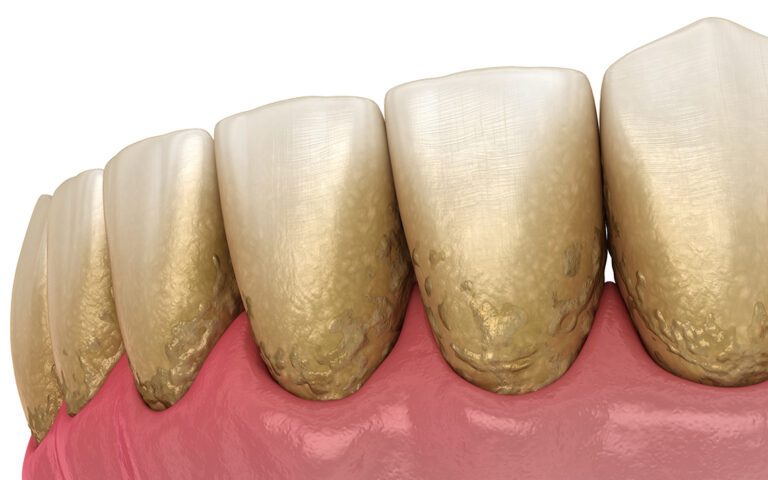What Is Tartar or Calculus?
You have probably noticed a fuzzy slippery coating on the surface of your teeth first thing in the morning or after you eat or drink something. Care to know what it is?
It’s called dental plaque, and it’s a thin, colourless, sticky film of bacteria that constantly forms on our teeth. Plaque formation begins almost twenty minutes after eating or drinking something, especially sugary foods and drinks.
What Happens If You Don’t Remove Plaque
“Plaque can cause oral health problems if not removed from the surface of your teeth regularly. Food leftover in our mouth, saliva, oral bacteria, and sugar combine to form this colourless coating between your teeth and along the gum line. Plaque needs to be removed regularly by proper brushing and flossing; otherwise, it can put your oral health at risk.
Dental plaque contains bacteria that can produce acid and damage tooth enamel, making it susceptible to tooth decay, cavities, and gum disease. Plaque can also adhere to dental fillings and other dental work. Not removing this sticky substance from your tooth surfaces can make your teeth look yellow. Unaddressed plaque can also lead to bad breath.
Tooth Enamel: the outermost layer of your teeth and the most visible layer; it’s a protective layer for your teeth and the most mineralised substance in your body. Because enamel has no living cells, it cannot repair itself if destroyed by tooth decay or cavities.

How To Remove Plaque
You can easily remove plaque at home by maintaining proper oral hygiene. Good dental hygiene, regular brushing and flossing daily are great ways to remove plaque from your teeth and improve dental health.
Risk Factors For Plaque Build up
While everyone can develop plaque, some people have a relatively higher risk of developing excessive plaque buildup:
- People who smoke
- People who consume lots of sugary and starchy foods
- People who have a dry mouth
- People who do not practise proper oral hygiene
What Is Tartar or Dental Calculus?
“Hardened Plaque”
Because plaque continuously forms on your teeth, it must be constantly and adequately brushed away to prevent dental health problems.
If you let plaque continue to accumulate, it mineralises into a hard substance called calculus or tartar. Dental calculus is caused by plaque buildup; it’s a hard, yellow or brown deposit firmly attached to a tooth surface. Only a dental professional can remove it. Dental calculus forms below and above the gum line after almost two weeks if plaque has not been removed from your teeth.

How Does Tartar Affect Teeth and Gums?
Plaque and tartar: Enemies of Excellent Oral Health.
“Prevent dental calculus buildup to prevent several dental health problems.”
Tartar buildup makes dental cleaning challenging for you because it makes your gums sensitive. Not being able to brush or floss means more tartar buildup.
Things can worsen: Calculus attracts plaque more and more, which means another calcified material layer.
You cannot remove tartar at home by brushing or flossing because it is firmly attached to your teeth and cannot be removed by a toothbrush. Tartar buildup needs professional cleaning done by a dental hygienist in a dentist’s office.
Calculus buildup above your gum line can irritate your gums and increase the risk of periodontal disease or gum disease.
Gingivitis, the early stage of gum disease, can be caused by plaque and tartar buildup. However, it can be reversed by practising proper dental hygiene and cleaning during your regular dental visits. If gingivitis is left unaddressed, it can turn into a serious gum disease referred to as periodontitis.
Below you can see some oral health issues that periodontal diseases can cause:
- Red or inflamed gums
- Bleeding gums
- Loose teeth
- Tooth loss
- Bone
- Pain while chewing
Gum disease is a serious oral health issue and needs urgent dental care. To learn more about gum disease and its negative oral health effects, you can read our article here:
https://www.puredentistry.com.au/about-gum-disease
Types of Dental Calculus
The location of tartar relative to the gumline determines the type of calculus. Two kinds of tartar or calculus include supragingival and subgingival.
Supragingival Calculus
Supragingival calculus or tartar forms above the gum line.
They are visible and easier to remove by professional dental cleaning in your dentist’s office.
Subgingival Calculus
Dental calculus removal is relatively harder for subgingival calculus because they form below the gum line.

Preventative Measures to Reduce Calculus
Dental Care Tips For Plaque and Tartar Control
Maintaining a good dental care routine and visiting your dentist routinely can be effective preventive measures to avoid plaque buildup on your teeth.
- Remove plaque regularly to prevent tartar formation on your teeth.
- Brush your teeth twice a day with fluoride toothpaste.
- According to some studies, brushing your teeth with baking soda can effectively remove plaque and surface stains. (Make sure you seek a professional dentist’s advice on the matter)
- Floss daily to get rid of food particles between your teeth.
- Rinse your mouth with an antibacterial mouthwash to reduce plaque buildup.
- Arrange regular dental visits every six months to ensure proper oral health.
- Keep a balanced diet. Avoid having too many sugary foods or drinks.
- Make sure you rinse your mouth with water after snaking.
- Try to quit smoking to minimise your risk of plaque formation.
- Keep your body hydrated and consume plenty of water to avoid dry mouth.
Removing Calculus
Scaling and Root Planing Treatment: “A Deep Cleaning”
Calculus removal is not possible at home with standard brushing and should be done by a professional dental hygienist. Your dentist will use an ultrasonic device with high-frequency vibrations and water to remove tartar.
Scaling and root planing are effective methods of removing plaque and tartar from above and below the gumline. The treatment is a restorative dental procedure and is done to prevent calculus from causing further damage like bone loss




































